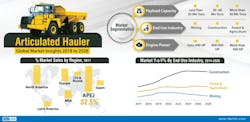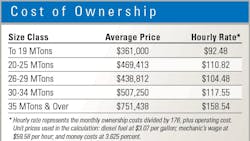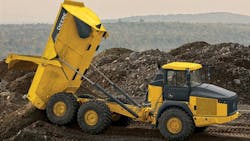Articulated dump trucks (ADTs) are enjoying a nice comeback thanks to the increased infrastructure and building work that leads to more work for the excavators and wheel loaders that load them. Meanwhile, manufacturers are continuing to enhance their haulers with features to make operation easier and more cost-effective.
“In 2018, the ADT market had its first year of growth since 2014, and was up significantly, at nearly 30 percent over 2017,” says a Doosan marketing manager.
“So far, through July 2019, ADTs have continued strong growth at a rate of 23 percent,” he says. “Most of the growth has occurred in construction-related markets and dealer-owned rental facilities.”
He notes that recent plans for increased infrastructure spending have spurred momentum, but, “the increase in rental business also indicates that some are cautious about the long-term implications of the administration’s future plans—and aren’t quite ready to go all-in with equipment purchases.”
The increased infrastructure and building work that is going on introduces a ripple effect: When excavators and loaders are doing well, so too are ADTs.
“The ADT market has been strong,” says John Deere’s Cory Ouellette, product marketing manager for ADTs and scraper systems. “These machines are critical in mass earthmoving, quarry and aggregate sites, and site-development applications. When other product markets are healthy, particularly loading tools like excavators and wheel loaders, the truck market is magnified because multiple trucks are used on a single loading tool.”
When considering an ADT purchase, Komatsu product marketing manager Sebastian Witkowski reminds managers to evaluate their existing fleets. “The most important consideration an organization can take into account when thinking of an ADT purchase is their existing fleet,” he says. “With the obvious goal of increasing productivity and efficiency, managers should look from the perspective of right-sizing their fleet and tailoring purchases to fit their existing operation. Often overlooked aspects like loading tool size, existing truck fleet, and operator skill level could all have an impact on overall job site efficiency. Ignoring these aspects will likely negate any gains brought on by a ‘bigger and faster is better’ mentality.”
Ouellette also addresses operator skill level. “Operation managers should take into consideration that ADTs are typically operated by the newest or least-trained operators on a job site,” he says. “Therefore, consideration for a truck that is easy to operate is important.”
Oullette explains that his company has several automated features to help operators. “One of our features is Auto Dump, which allows the operator to dump loads and return the bin with a simple push of a dedicated lever,” he says. “Another ease-of-operation feature is downhill descent control, which uses the transmission retarder to automatically hold travel speed on slopes.”
Operator performance can be a big key to keeping operating costs down, according to Witkowski.
“Consistent operator performance from all skill levels is paramount in reducing operating costs,” Witkowski says. “Avoiding lengthy cycle times, unexpected wear, and unplanned downtime can lead to a positive impact in productivity.”
Witkowski says Komatsu’s ADT truck line makes use of automatic systems that run without the need for operator input and can help bring consistent performance, particularly on job sites with challenging terrain.
“Komatsu’s traction control system monitors wheel speeds and automatically engages and disengages wheel brakes individually, transferring power through the differential to the tire with the most traction,” Witkowski says. “This system allows for maximum machine performance in soft and slippery ground conditions, while maximizing cycle times and reducing tire wear that can come from 100-percent differential lock-up systems.”
Another feature, the Komatsu Advanced Transmission with Optimum Modulation Control System, is a six-speed, fully automatic transmission that uses an advanced electronic system designed to eliminate shift shock and torque cutoff, so the engine operates in the most efficient range. The electronic system automatically selects the gear based on vehicle speed, engine speed, and the shift position selected. “This results in powerful acceleration, smooth down-shifting, and synchronized engine speed when climbing slopes,” Witkowski says.
Also, when it comes to costs, don’t overlook operator habits such as service brake use, says Volvo Construction Equipment’s Rob Palermo, the company’s product manager for articulated haulers.
“Excessive service brake use can rack up unnecessary maintenance bills,” he says. “Some hauler operators tend to ride the brakes or aren’t adequately trained to use engine braking and the retarder. [Volvo’s] ActiveCare Direct [machine monitoring] monthly reports automatically flag those machines and operators who exceed 80 percent service brake usage, helping customers avoid costly brake replacement and identify training opportunities for their operators.”
Going further, Palermo says overuse of the differential lock can lead to problems.
“Volvo articulated haulers are designed with differential locks that allow for 4×6 or 6×6 drive combinations. By running in 4×6, the operator saves significantly on fuel and reduces tire wear,” Palermo says. “Generally, 6×6 should only be used when operating on incredibly difficult terrain.”
The company’s machine monitoring system will automatically flag any hauler running in 6×6 more than 50 percent of the time, Palermo says. “As an example, if this helps avoid one tire change interval over the life of the machine, that could equate to a potential $25,000 cost savings,” he says.
Job site conditions also dictate opportunities to pare down costs, according to Palermo.
“Every site is different, but it may be worth it for managers to look at upgrading to a full-suspension model over a conventional model,” Palermo says. “The cost difference is in the neighborhood of 20 percent between the two machines, so it’s important that buyers make sure it’s a worthy investment for their operation. But, if the upgrade makes sense, customers could see profitable benefits such as faster cycle times, reduced fleet sizes, and a lower cost per ton.”
In addition, Palermo says managers should take a look at the larger, 60-ton ADTs that have been introduced in recent years.
“With larger payload haulers now available...operations can evaluate their job site conditions, operating hours, specifications, and more, to determine if one larger hauler can replace two smaller machines to get the work done,” Palermo says. “If so, this can drastically reduce operating costs year-over-year.”
Doosan’s Kleingartner traces cost savings to maintenance.
“The biggest factor in minimizing articulated dump truck operating costs is managing the truck’s maintenance plan,” Kleingartner says. “Fleet managers should ensure that job site superintendents and/or operators are properly following the recommended maintenance plan and precautions in the operation and maintenance manual.
“Keeping operating costs down starts with something as simple as a daily operator walk-around and inspection, looking for any potential maintenance issues, such as leaks, and repairing them,” Kleingartner says. “ADT operators need to make sure all daily service points are being completed before driving the trucks. As the ADT reaches milestone service intervals, such as 100 and 500 hours, the fleet manager should work with the company’s maintenance department or the local dealer to perform the recommended service outlined in the manual.”
Kleingartner also advises managers to watch utilization and idle time. As it does with other operator habits, telematics systems can play a vital role here.
“If a fleet manager looks at the cost of ownership from an hourly standpoint, it will be lower if the truck is moving material more frequently rather than sitting idle, waiting to be loaded by a wheel loader or an excavator,” Kleingartner says. “Managers can remotely monitor usage with telematics management systems. So a fleet manager can bring up a particular project...and see in near real-time where the truck is, what it is doing, and how much fuel it’s using.”
About the Author
Frank Raczon
Raczon’s writing career spans nearly 25 years, including magazine publishing and public relations work with some of the industry’s major equipment manufacturers. He has won numerous awards in his career, including nods from the Construction Writers Association, the Association of Equipment Manufacturers, and BtoB magazine. He is responsible for the magazine's Buying Files.




